New英语复合句翻译
初三英语复合句与翻译结合单选题40题

初三英语复合句与翻译结合单选题40题1. I don't know ______ he will come tomorrow.A. ifB. whenC. whatD. where答案:A。
本题考查宾语从句的引导词。
选项A“if”表示“是否”,在句中符合语义,即“我不知道他明天是否会来”。
选项B“when”表示“什么时候”,但句子重点不是询问来的时间。
选项C“what”表示“什么”,不符合句子意思。
选项D“where”表示“哪里”,也不符合句子要表达的意思。
2. Our teacher told us that the earth ______ around the sun.A. goesB. wentC. goingD. to go答案:A。
此题考查宾语从句中的客观真理。
地球绕着太阳转是客观真理,用一般现在时,主语是“the earth”,谓语动词用第三人称单数形式“goes”。
选项B“went”是过去式,不符合客观事实。
选项C“going”不能单独作谓语。
选项D“to go”是动词不定式,不能作谓语。
3. Could you tell me ______?A. where is the post officeB. where the post office isC. where was the post officeD. where the post office was答案:B。
宾语从句要用陈述句语序,排除选项 A 和C。
主句“Could you tell me”是委婉语气,不是过去时态,从句根据实际情况用一般现在时,所以是“where the post office is”。
选项D“was”是过去式,不符合。
4. I wonder ______ he has finished his homework.A. thatB. ifC. whatD. how答案:B。
本题考查宾语从句引导词。
英语复合句的翻译方法

Literal translation can retain the rhetorical style, language features, and expression of the original text, making the translation more faithful to the original text and easy to understand.
01
When translating English compound sentences, attention should be paid to preserving the style and characteristics of the original text, such as rhetorical devices, tone, etc.
Grammar correctness
When translating compound sentences, attention should be paid to the correctness of grammar to ensure that the structure, tense, voice, and other aspects of the sentence are consistent with the original text.
The translator organizes the translated text to ensure a logical flow, using appropriate punctuation marks and presence structure
Preserving the original meaning
高中英语高级句型例句及翻译
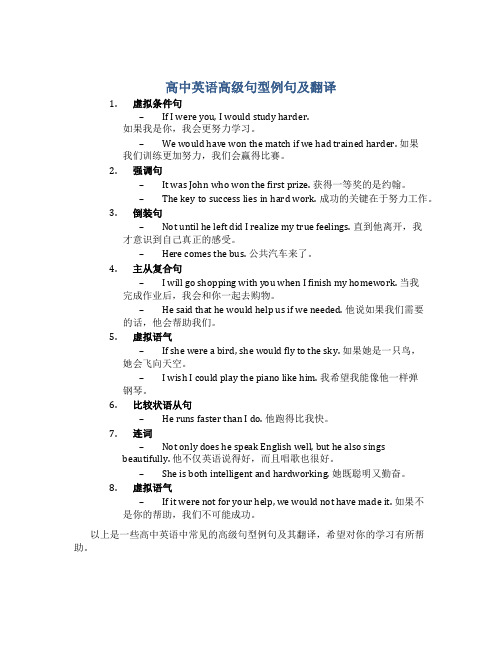
高中英语高级句型例句及翻译1.虚拟条件句–If I were you, I would study harder.如果我是你,我会更努力学习。
–We would have won the match if we had trained harder. 如果我们训练更加努力,我们会赢得比赛。
2.强调句–It was John who won the first prize. 获得一等奖的是约翰。
–The key to success lies in hard work. 成功的关键在于努力工作。
3.倒装句–Not until he left did I realize my true feelings. 直到他离开,我才意识到自己真正的感受。
–Here comes the bus. 公共汽车来了。
4.主从复合句–I will go shopping with you when I finish my homework. 当我完成作业后,我会和你一起去购物。
–He said that he would help us if we needed. 他说如果我们需要的话,他会帮助我们。
5.虚拟语气–If she were a bird, she would fly to the sky. 如果她是一只鸟,她会飞向天空。
–I wish I could play the piano like him. 我希望我能像他一样弹钢琴。
6.比较状语从句–He runs faster than I do. 他跑得比我快。
7.连词–Not only does he speak English well, but he also singsbeautifully. 他不仅英语说得好,而且唱歌也很好。
–She is both intelligent and hardworking. 她既聪明又勤奋。
8.虚拟语气–If it were not for your help, we would not have made it. 如果不是你的帮助,我们不可能成功。
2024高考英语-复合句写作之名词性从句
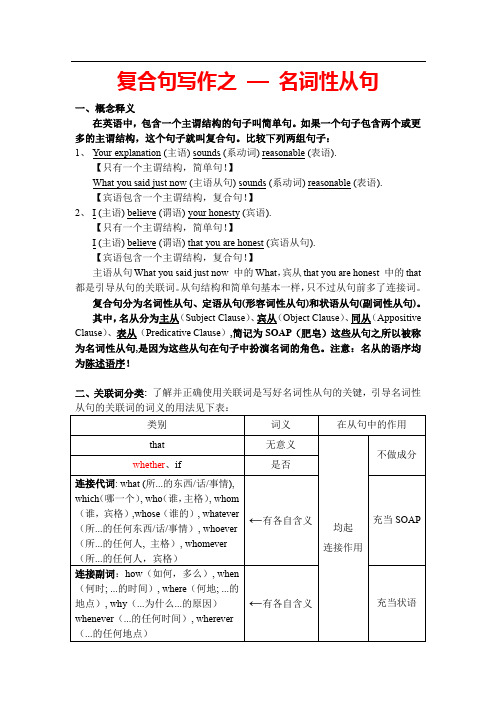
复合句写作之—名词性从句一、概念释义在英语中,包含一个主谓结构的句子叫简单句。
如果一个句子包含两个或更多的主谓结构,这个句子就叫复合句。
比较下列两组句子:1、Your explanation (主语) sounds (系动词) reasonable (表语).【只有一个主谓结构,简单句!】What you said just now (主语从句) sounds (系动词) reasonable (表语).【宾语包含一个主谓结构,复合句!】2、I (主语) believe (谓语) your honesty (宾语).【只有一个主谓结构,简单句!】I (主语) believe (谓语) that you are honest (宾语从句).【宾语包含一个主谓结构,复合句!】主语从句What you said just now 中的What,宾从that you are honest 中的that 都是引导从句的关联词。
从句结构和简单句基本一样,只不过从句前多了连接词。
复合句分为名词性从句、定语从句(形容词性从句)和状语从句(副词性从句)。
其中,名从分为主从(Subject Clause)、宾从(Object Clause)、同从(Appositive Clause)、表从(Predicative Clause),简记为SOAP(肥皂)这些从句之所以被称为名词性从句,是因为这些从句在句子中扮演名词的角色。
注意:名从的语序均为陈述语序!二、关联词分类: 了解并正确使用关联词是写好名词性从句的关键,引导名词性★It作形式主语的实质:例:英语晚会将会在何处举行还没有宣布。
_____________________________________________________________________ STEP1: 在中文的概念中,发现应由一个句子充当主语;STEP2: 用It整体取代该句子,充当傀儡;并置于句首;STEP3:选择适当关联词,将充当主语的句子置于句末。
新概念第二册课文翻译及学习笔记【Lesson85、86、87】

【导语】新概念英语作为⼀套世界闻名的英语教程,以其全新的教学理念,有趣的课⽂内容和全⾯的技能训练,深受⼴⼤英语学习者的欢迎和喜爱。
为了⽅便同学们的学习,为⼤家整理了⾯的新概念第⼆册课⽂翻译及学习笔记,希望为⼤家的新概念英语学习提供帮助!《新概念英语》85课: Never too old to learn 活到⽼学到⽼【课⽂】First listen and then answer the question.听录⾳,然后回答以下问题。
How long has Mr. Page been teaching?I have just received a letter from my old school, informing me that my former headmaster, Mr. Stuart Page, will be retiring next week. Pupils of the school, old and new, will be sending him a present to mark the occasion. All those who have contributed towards the gift will sign their names in a large album which will be sent to the headmaster's home. We shall all remember Mr. Page for his patience and understanding and for the kindly encouragement he gave us when we went so unwillingly to school. A great many former pupils will be attending a farewell dinner in his honour next Thursday. It is a curious coincidence that the day before his retirement, Mr. Page will have been teaching for a total of forty years. After he has retired, he will devote himself to gardening. For him, this will be an entirely new hobby. But this does not matter, for, as he has often remarked, one is never too old to learn.【课⽂翻译】我刚刚收到母校的⼀封信,通知我说以前的校长斯图亚特.佩奇先⽣下星期就退休了。
英语简单句+复合句-翻译练习-用

英语简单句+复合句-翻译练习-用-CAL-FENGHAI.-(YICAI)-Company One1英语简单句翻译练习1.由于大火的结果,成千上万的人失去了家园。
2.学生们一路上不停地说笑。
3.我妈妈叫我做作业,而不是洗碗。
4.在公共场合,不允许人们吸烟。
5.昨天下午我妈在那家商店给我买了橡皮、小刀和铅笔盒等。
6.我英语发音方面有些困难。
7.祝你在深圳玩得愉快。
8.这顶帽子是由手工而不是机器做的。
9.明天晚上我要到机场去送我姨妈。
10.所有的学生都必须遵守校规。
11.事实上,我非常喜欢学英语。
12.有时,英语口语完全不同于英语书面语。
13.我们学校图书馆将为学生们提供各种类型的书。
14.下一年我的家乡将建一所新医院。
15.许多人在这次车祸中丧生,仅有少数幸运者没有受伤。
16.玉米最先在美国种植。
17.飞机比火车重20倍。
18.每人只允许从图书馆借两本书。
19. 吃新鲜的蔬菜和水果对你的健康很有益。
20.由于老师的帮助,他考上了一所名牌学校。
21.我每隔两天(每三天)去那里一趟。
复合句的翻译练习1.当你离开教室时,务必关灯。
2.你一旦开始,就必须进行下去。
3.如果你不快点,你就会误了火车。
4.这个男孩说他曾经和一位美国人讲过英语。
5.老师告诉我们英国英语与美国英语拼写方面有些不同。
6.如果今天下午下雨的话,我就乘出租车去上学。
7.为了赶上头班车我明天得起得早点。
8.科学家担心有一天一次更大的地震会袭击这座城市。
9.建于1960年的那栋房子在这次地震中巍然屹立。
10.研究地震的人们认为把房子建在沙地上是不安全的。
11.去年地震时,失去家园的人数多达5千。
12.正站在我们教室前面的那位女士是我们的英语老师。
13.在西方国家人人都喜欢牛奶作成的奶酪。
14.当你说英语时,必须让别人听懂。
15.你认为他来回答这些问题很难吗?16.据报道在那个地区又建了一所新学校。
17.她出生的那个村庄很美。
18.借走我自行车的那个人叫Paul。
英语复合句翻译PPT课件

Teaching objectives
To familiarize learners with the basic translation principles and techniques for English compound
sentences.
To provide learners with practical translation exercises and examples to enhance their translation skills.
Definition of compound sentences
01
复合句是由一个主句和一个或多 个从句组成的句子。
02
主句是句子的主体,表达完整的 思想,而从句则对主句进行补充 、解释或修饰。
Classification of compound sentences
并列复合句
由两个或多个并列从句组成,各 从句之间由并列连词连接,表示 并列关系。
主从复合句
由一个主句和一个或多个从句组 成,从句由关联词引导,修饰主 句。
The characteristics of compound sentences
01
02
03
结构复杂
复合句通常包含多个从句 和修饰语,结构较为复杂。
信息量大
复合句能够表达更多的信 息,使句子更加丰富和具 体。
表达力强
复合句能够更准确地表达 复杂的思想和情感,增强 语言的表达力。
Translation of compound sentences related to
technology
01
技术英语复合句的特点
技术英语复合句通常涉及专业术语,句式结构较为固定,表述严谨且逻 辑性强。
大学英语四级考试5个翻译技巧

英语四级考试考前必知:5个翻译技巧①在翻译前,先确定可以正确理解文章意思。
即便遇到很难的说法,也可以先变成简单的中文再进行翻译。
如:年夜饭译:The annual reunion dinner析:指过年的那顿团圆饭,每年一次。
所以在翻译时要表达出这个团聚的含义②中文没有过去式,但是英文有啊,别忘记翻译时态的转换如:我在第一段说过,我刚从大学毕业。
译:As I said in my first paragraph, I was fresh from college。
析:中文的时态是依赖一些汉字表达,英文根据动词的变化形式展示。
文中的“过”英文采用一般过去时翻译③有些介词可能会帮到忙,比如with+ 名词的结构,就很多见。
如:这里有许多山脉,生长着大片的森林,贮藏着丰富的矿产。
译:There are mountain ranges here with extensive forests and rich mineral resources。
析:生长和储藏这两个动词在译文中并没有以动词的形式翻译,转译为英文的介词④应用英语的固定句型,这些句式可以加分,绝对是亮点如:是巴斯德发现了疾病是由活着的病菌引起的。
译:It was Pasteur who discovered that diseases are caused by living germs。
析:此句应用了英文的强调句进行翻译⑤分析上下句之间的逻辑关系,添加一些简单的连词,英文的译文会更漂亮。
如:汽油贵得惊人,我们就很少用车。
译:Because the price of gasoline was fantastically high, we seldom used our cars。
析:在原文中并没有出现表示原因类的词汇,但是在译文中根据两个句子之间的逻辑关系添加了表示原因的从句连词四六级复习秘笈:一、词类转译技巧在翻译过程中,有些句子可以逐词对译,有些句子则由于英汉两种语言的表达方式不同,就不能逐词对译,只能将词类进行转译之后,方可使译文显得通顺、自然;对词类转译技巧的运用须从四个方面加以注意。
复合句结构翻译

3.这就是我正在寻找的那本字典。
(that, look for)This is the very dictionary that I’m looking for.定从19.好的鞋、衣服和背包是你去徒步旅行的必需品。
(basic, equipment, need for)Good shoes, clothes and a backpack are the basic equipment you need for your hiking.定从15.我们需要一个有活力的、能够真正地刺激成员更加努力工作的团队领导者。
(who)We need a dynamic team leader who can really motivate the members to work harder.定从20.不管你取得了多么大的进步,你也一定不能骄傲。
(be proud, whatever/ no matter what)You mustn’t be proud whate ver/ no matter what great progress you may have made.定从21.这些就是我们这样做的理由。
(why)These are the reasons why we do so.定从1.我们什么时候举行运动会仍然是个问题。
(when)When we shall have our sports meeting is still a question.主从2.信上说他们将在星期五离开。
(say, that)The letter says that they are leaving on Friday.宾从8.我们现在应该帮助任何需要帮助的人。
(favor, whoever)We should do a favor for whoever needs help at present.宾从10.令她惊讶的是,这个小女孩懂得如此多的事情。
英语复合句长句带翻译例句

英语复合句长句带翻译例句1、We heard the news that our team had won.我听到消息说我们的队伍获胜了。
2、Whether he will come is not clear.他会不会赴会仍是未知数。
3、What he wants to tell us is not clear.他要跟我们说什么,还不清楚。
4、It is known to us how he became a writer.我们都知道他是如何成为一名作家的。
5、He has told me that he will go to Shanghai tomorrow.他已经告诉我他明天要去上海。
6、I insist that she (should) do her work alone.我坚持要她自己工作。
7、She always thinks of how she can work well.她总是在想怎样能把工作做好。
8、You should have put the book where you found it.你本来应该把书放回原来的地方。
9、Much as I respect him, I can’t agree to his proposal.尽管我很尊敬他,我却不同意他的建议。
10、Food is to men what oil is to machine.食物之于人,犹如油之于机器。
11、As (he was) young, he learned how to ride a bike.他小时候就学会了骑自行车。
12、Whenever (she is) free, she often goes shopping.她有空就去逛商店。
13、Work hard when (you are) young, or you'll regret.少壮不努力,老大徒伤悲。
14、He won't go there with us unless (he is) invited.除非受到邀请,否则他不会和我们一道去那里。
英语复合句的翻译方法演示文稿

(一)定语从句的翻译-合译法、分译法、转译法
1.合译法。
合译法是把主句和定语从句合译成一个单句的译法, 主要以限制性的定语从句为主。具体做法可以译成 定语(“的”字结构)、谓语、兼语式的一部分或带 有“这”字的单句。
1. 译成定语(“的”字结构). A man who doesn’t try to learn from others cannot hope to achieve much. 一个不向别人学习的人是不能指望有多少成就的。 The few points which the president stressed in his report are very important indeed. 院长在报告中强调的几点的确很重要。
2.译成谓语的一部分。
There are many students in this class who come from big cities. 这个班的许多学生来自大城市。
There are some chemical fuels that are clean and smokeless. 有些化学燃料是洁净无烟的。
She was very patient towards the children, which her husband seldom was. 她对孩子们很耐心,她丈夫却很少这样。
有些定语从句中的关系代词并不是指主句中的一个词,而是 指整个主句,一般将其译成“这”或“这一点”。主句的译 本身不是一个分句,而是“这”的同位语。
4.译成连动式的一部分。
He took a bottle of wine out of his pocket, which he began to drink slowly. 他从衣兜里掏出一瓶酒慢慢地喝起来。
简单并列复合句翻译
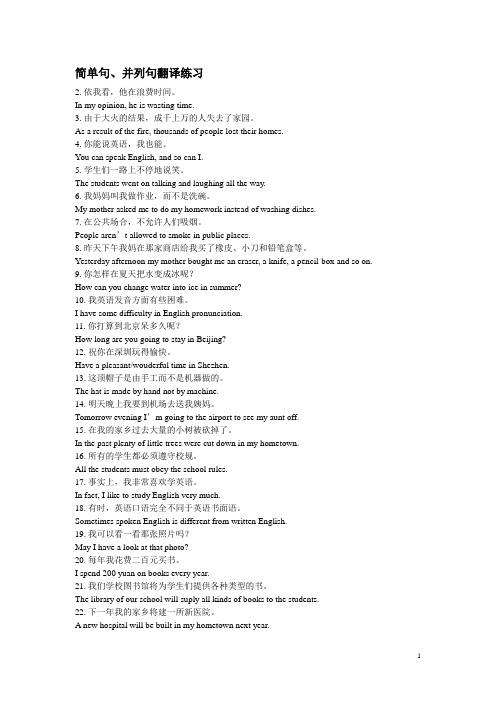
简单句、并列句翻译练习2. 依我看,他在浪费时间。
In my opinion, he is wasting time.3. 由于大火的结果,成千上万的人失去了家园。
As a result of the fire, thousands of people lost their homes.4. 你能说英语,我也能。
You can speak English, and so can I.5. 学生们一路上不停地说笑。
The students went on talking and laughing all the way.6. 我妈妈叫我做作业,而不是洗碗。
My mother asked me to do my homework instead of washing dishes.7. 在公共场合,不允许人们吸烟。
People aren’t allowed to smoke in public places.8. 昨天下午我妈在那家商店给我买了橡皮、小刀和铅笔盒等。
Yesterday afternoon my mother bought me an eraser, a knife, a pencil-box and so on.9. 你怎样在夏天把水变成冰呢?How can you change water into ice in summer?10. 我英语发音方面有些困难。
I have some difficulty in English pronunciation.11. 你打算到北京呆多久呢?How long are you going to stay in Beijing?12. 祝你在深圳玩得愉快。
Have a pleasant/wouderful time in Shezhen.13. 这顶帽子是由手工而不是机器做的。
The hat is made by hand not by machine.14. 明天晚上我要到机场去送我姨妈。
英语翻译中直译和意译

直译是基础,意译是补充能直译就尽量直译,不能直译就采取意译1. Their accent couldn‘t fool a native speaker. A. 他们的口音不能愚弄本地人B.本地人是不会听不出他们是外乡人的。
C.本地人一听他们的口音便知道他们是外乡人的。
2. Smashing a mirror is no way to make an ugly person beautiful ,nor is it a way to make social problems evaporate.意译:砸镜子并不能解决实际问题。
直译:砸镜子并不能使丑八怪变漂亮,也不能使社会问题烟消云散。
3.He felt a rush of fear churning his stomach.直译:他感到一阵恐惧涌上胃口意译:他感到一阵恐惧涌上心头4. He bent solely upon profit. A. 他只屈身与利润之前B.只有利润才使他低头。
C.他惟利是图5. Would there be any possibility of having breakfast on the train before we are decanted in Munich ?A.当我们在慕尼黑被腾出车厢之前有任何在火车上吃早饭的可能性吗?B.我们在慕尼黑被腾出车厢之前,有可能在火车上吃早饭吗?6. He had about as much chance of getting a job as of being chosen mayor of Chicago. A.他找到工作的机会和当选芝加哥市长的机会差不多B.他找到工作的机会简直跟当选芝加哥市长同样困难。
C.他找到工作的机会简直微乎其微。
正说与反说1.The administration was free corruption. 这届政府没有腐败现象2. Wet paint. 油漆未干3.I remained confused about the problem.这个问题我还是不懂4. They are dependent on each other.他们谁也离不开谁5. He is far from what I expected.他远不是我想象的那样。
英语复合句的翻译)译文
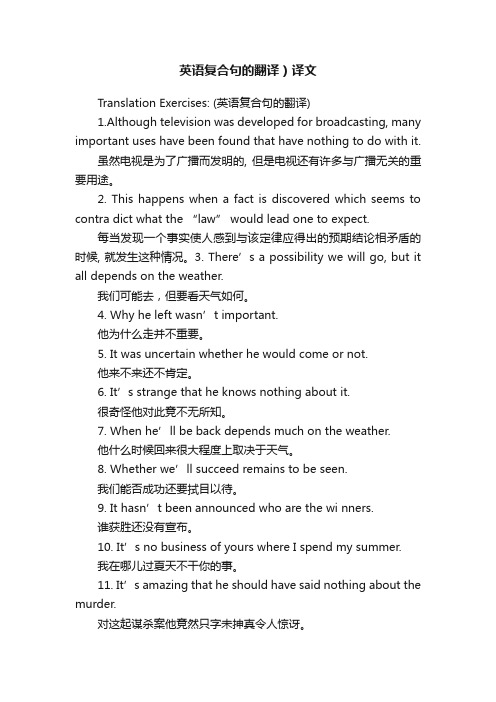
英语复合句的翻译)译文Translation Exercises: (英语复合句的翻译)1.Although television was developed for broadcasting, many important uses have been found that have nothing to do with it.虽然电视是为了广播而发明的, 但是电视还有许多与广播无关的重要用途。
2. This happens when a fact is discovered which seems to contra dict what the “law” would lead one to expect.每当发现一个事实使人感到与该定律应得出的预期结论相矛盾的时候, 就发生这种情况。
3. There’s a possibility we will go, but it all depends on the weather.我们可能去,但要看天气如何。
4. Why he left wasn’t important.他为什么走并不重要。
5. It was uncertain whether he would come or not.他来不来还不肯定。
6. It’s strange that he knows nothing about it.很奇怪他对此竟不无所知。
7. When he’ll be back depends much on the weather.他什么时候回来很大程度上取决于天气。
8. Whether we’ll suc ceed remains to be seen.我们能否成功还要拭目以待。
9. It hasn’t been announced who are the wi nners.谁获胜还没有宣布。
10. It’s no business of yours where I spend my summer.我在哪儿过夏天不干你的事。
复合句的译法
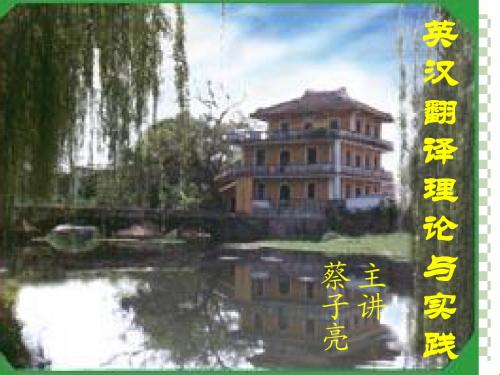
4) 有些定语从句汉译时可不必重复关系 代词所代替的词,而将其译成人称代 词 “他” ﹑“他们” 等。例如:
I
told the news to Robert, who (and
he) told it to his friend Larry, and soon the news spread all over the campus.
再如:
He
insisted on building another house which he had no use for. 他坚持再建一座他不用的房子。× 他坚持再建一座房,这房他不用。× 他虽自己不用,但仍坚持再建一座房。 尽管他并没有这样的需要,仍坚持再 建一座房子。 他坚持再建一座房子,尽管他并无此 需要。
1) 一般说来,限定性定语从句(尤其是 简短的定语从句)多半译成汉语的前置 定语,修饰其后的先行词。例如: To be sure, a great rebuilding project would give jobs to many of those people who need them. 诚然,一个宏伟的重建计划也许能为 许多需要工作的人提供就业机会。 He who has never tasted what is bitter does not know what is sweet. 没有吃过苦的人不知道什么是甜。
这就是那只捕杀了偷吃了放在纸盒
里的蛋糕的老鼠的猫。 这就是那只捕杀了老鼠的猫。老鼠 偷吃了放在纸盒里的蛋糕。
5. This is the cat that killed the rat that ate the cake that lay in the paper box that Mike made. 这就是那只捕杀了偷吃了放在迈克 做的纸盒里的蛋糕的老鼠的猫。 这就是那只捕杀了老鼠的猫。老鼠 偷吃了放在迈克做的纸盒里的蛋糕。 这就是那只捕杀了老鼠的猫。老鼠 偷吃了放在纸盒里的蛋糕。纸盒是 迈克做的。
英译汉翻译方法介绍---句子的翻译
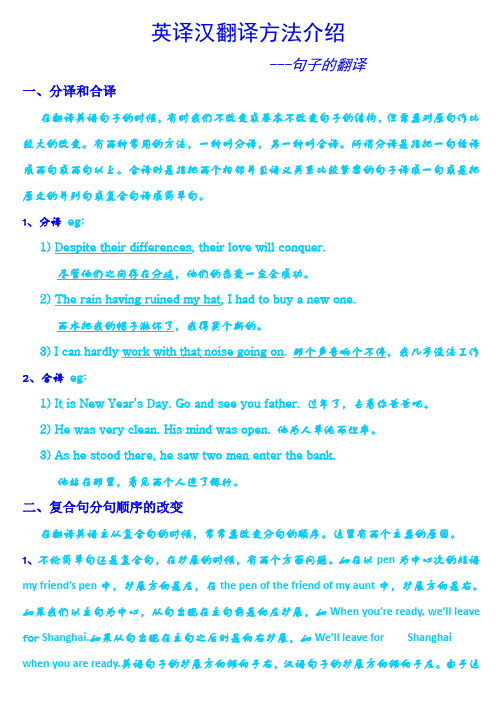
英译汉翻译方法介绍---句子的翻译一、分译和合译在翻译英语句子的时候,有时我们不改变或基本不改变句子的结构,但需要对原句作比较大的改变。
有两种常用的方法,一种叫分译,另一种叫合译。
所谓分译是指把一句话译成两句或两句以上。
合译则是指把两个相邻并且语义关系比较紧密的句子译成一句或是把原文的并列句或复合句译成简单句。
1、分译eg:1) Despite their differences, their love will conquer.尽管他们之间存在分歧,他们的恋爱一定会成功。
2) The rain having ruined my hat, I had to buy a new one.雨水把我的帽子淋坏了,我得买个新的。
3) I can hardly work with that noise going on. 那个声音响个不停,我几乎没法工作2、合译eg:1) It is New Year’s Day. Go and see you father. 过年了,去看你爸爸吧。
2) He was very clean. His mind was open. 他为人单纯而坦率。
3) As he stood there, he saw two men enter the bank.他站在那里,看见两个人进了银行。
二、复合句分句顺序的改变在翻译英语主从复合句的时候,常常要改变分句的顺序。
这里有两个主要的原因。
1、不论简单句还是复合句,在扩展的时候,有两个方面问题。
如在以pen为中心次的短语my friend’s pen中,扩展方向是左,在the pen of the friend of my aunt中,扩展方向是右。
如果我们以主句为中心,从句出现在主句前是向左扩展,如When you’re ready, we’ll leave for Shanghai.如果从句出现在主句之后则是向右扩展,如We’ll leave for Shanghai when you are ready.英语句子的扩展方向倾向于右,汉语句子的扩展方向倾向于左。
复合句的翻译文档

1、I gave my youth to the sea and I gave my wifemy old age我把青春献给了海洋,等我回家见到凄子时,已是白发苍苍。
2、S he went back to take care of her husbandwho was seriously ill.她回去照料病重的丈夫。
合译法。
1、A man who doesh t try to learn from others cannot hope to achieve much.一个不向别人学习的人是不能指望有多少成就的。
2、T he few points which the president stressed in his report are very important indeed.院长在报告中强调的几点的确很重要3、T here are many students in this class who come from big cities.这个班的许多学生来白大城市。
4、T here are some chemical fuels that are clean and smokeless有些化学燃料是洁净无烟的。
5、T here have been good results in the experiments that have given him great encouragement.实验中的良好结果给了他莫大的鼓舞。
6、I need someone who can instruct me in my English study.我需要一个人来指导我学英语。
7、When I passed by, I saw a man who was writing something in the room我从这里路过时,看到一个人在屋子里写字。
8、I have three letters which I must write this afternoon. 我有三封信必须今天下午写出来。
英语复合句的翻译)译文

Translation Exercises: (英语复合句的翻译)1.Although television was developed for broadcasting, many important uses have been found that have nothing to do with it.虽然电视是为了广播而发明的, 但是电视还有许多与广播无关的重要用途。
2. This happens when a fact is discovered which seems to contra dict what the “law” would lead one to expect.每当发现一个事实使人感到与该定律应得出的预期结论相矛盾的时候, 就发生这种情况。
3. There’s a possibility we will go, but it all depends on the weather.我们可能去,但要看天气如何。
4. Why he left wasn’t important.他为什么走并不重要。
5. It was uncertain whether he would come or not.他来不来还不肯定。
6. It’s strange that he knows nothing about it.很奇怪他对此竟不无所知。
7. When he’ll be back depends much on the weather.他什么时候回来很大程度上取决于天气。
8. Whether we’ll succeed remains to be seen.我们能否成功还要拭目以待。
9. It hasn’t been announced who are the wi nners.谁获胜还没有宣布。
10. It’s no business of yours where I spend my summer.我在哪儿过夏天不干你的事。
- 1、下载文档前请自行甄别文档内容的完整性,平台不提供额外的编辑、内容补充、找答案等附加服务。
- 2、"仅部分预览"的文档,不可在线预览部分如存在完整性等问题,可反馈申请退款(可完整预览的文档不适用该条件!)。
- 3、如文档侵犯您的权益,请联系客服反馈,我们会尽快为您处理(人工客服工作时间:9:00-18:30)。
The translation of the antient Chinese architectural style摘要:关于建筑的文本中,其中存在大量结构复杂的复合句。
因此,复合句的恰当翻译对保证该著作的翻译质量至关重要。
本论文以中国古代建筑结构为例,通过对比英汉句子在造句策略、句子结构以及重心位置方面的差异,分析了英语复合句中在转换成汉语时所面临的各种困难,提出了相应的翻译策略和翻译技巧,并且以具体的翻译例句验证了这些策略的有效性。
从文化翻译理论的视角,本文探讨了我国古代建筑文化中复合句的翻译技巧,主要包括顺序法、分割法、断句法、分流法和逆序法。
文章的研究对于英文复合句的翻译具有重要的意义。
关键词:古典建筑;复合句;翻译技巧Abstract:In the text of architecture, there are many complex sentences. Therefore, the proper translation of complex sentences is very important to guarantee the quality of translation. In this paper, the author takes the Chinese ancient architecture as an example to compare the differences between English and Chinese sentences in terms of sentence structure, sentence structure and the position of the center of gravity. It analyzes the difficulties in English complex sentence into Chinese when facing, and it puts forward corresponding translation strategies and translation skills, and it uses specific translation examples to verify the effectiveness of these strategies. From the perspective of cultural translation theory, this paper discusses the translation of complex sentences of ancient Chinese architectural culture, including the sequential method, segmentation method, segmentation method, distribution method and reverse order method. The study of the thesis is of great significance to the translation of English complex sentences.Key words: classical architecture; complex sentence; translation skillsCatalog1 Instruction (1)2 The basic language features of 2 compound sentences (1)2.1 sentence composition complex (1)2.2 word order is very different from Chinese (2)2.3 sentence making is mainly use the hypotaxis method (2)3 current problems in the translation of English complex sentences (2)4 the translation of Chinese architectural culture (4)4.1 Sequential translation (4)4.2 Reverse translation (4)4.3 Segmentation method (4)4.4 Shunt method (5)4.5 Reverse translation (5)5. Conclusion (6)Reference documentation (7)1 InstructionThere are great differences between the two languages, Chinese and English. There are one or more independent clause or some components of the subordinate clause in English complex sentence. Time and logical sequence is not exactly the same between the main clause and subordinate clause in complex sentences of Chinese and English. So their positions are not exactly the same. English has SVO structure; That is, the time of each component is closely linked through grammar. "The seven sentence patterns of English are derived and extended by the SV stable structure. Chinese has TC structure; that's the topic and the model. This is very different from the sentence structure of English. To grasp this is the premise of translation.The treatment of Noun Clauses is translation in regular sequence and the division in the translation. At the same time, the sentence level should be adjusted according to the logic of the sentence. Before translating noun clauses, we must first classify the meaning groups. This can accurately determine the sentence is composed of what information and then be processed into Chinese sentences based on the information. Here is more commonly used translation in regular sequence and the division in the translation. If close to English and Chinese word order, we can directly use ordinal translation. This can not only ensure the transmission of the original information, and it is also more convenient to do. If the English sentence structure and Chinese differences too large, at the same time the components are closely connected; Use the division in the translation here. We will be connected to the information in accordance with the characteristics of Chinese that are split into several sentences. So that readers can easily understand, but also it is in line with the characteristics of Chinese language. At the same time, we should find out the logic of the sentence. Because the characteristics of the paper are logical, the translation should be logical. The implicit logic of sentences must be expressed in Translation to ensure that the implicit logic can be embodied in the translation. Only in this way can we meet the characteristics of academic papers.2 The basic language features of 2 compound sentences2.1 sentence composition complex"The compound sentence is constituted by a main clause and one or more clauses in the sentence. In a sentence, usually it is the main body of the whole sentence, and can exist independently; However the clause is a sentence, which cannot exist independently." Although a clause cannot exist alone, it contains a subject and a predicate, just like a sentence. But the difference is that clauses often require an associated word to guide. Complex sentences can be roughly divided into two categories: principal and subordinate complex sentences and compound sentences. These two types of complex sentence can be subdivided into several different types of complex sentences, which leads to the difficulty of understanding of the original translation increases, so complex sentence has become a big problem in English translation.In some application articles, especially articles in trade, complex sentence is quite common, which mainly is the subordinate compound complex sentence, such as subject clauses, attributive clauses and appositive clauses etc.. This kind of complex sentence and general articles in English complex sentence be quite different in meaning aspect, that there is a clause and at least one clause sentences. In this kind of professional English, the compound sentence is often long, the sentence is modified and combined, and a complex sentence usually contains multiple clauses. This also brings a lot of trouble to English translation work.2.2 word order is very different from ChineseCompared with the Chinese, the main component of English sentence is roughly the same in word order, but due to different ways of thinking and expression of habit, two languages do exist some differences in word order indeed. these differences are mainly embodied and logical order is not the same place. When expressing or asking questions in English, people tend to take the idea of expressing the parts first and then expressing the whole, from small to large; The Chinese language is just the opposite, the Chinese like to take the first expression of the whole, re expression of the concept of the part, that is, from large to small way. For example, in the expression of the name, the English speaking countries are to make the name in the front, after the surname, while China is the opposite;When asked about the concept of expression, the order of the English speaking countries is the date in the former, the year after, however the order of the Chinese is years, months and days.2.3 sentence making is mainly use the hypotaxis methodEnglish sentence mainly adopts the shape method, with associated words explicit language means the connection, to express the logic and grammatical meaning; While Chinese sentences mainly use the hypotaxis method, clauses expressing grammatical meaning and logic relation by word or sentence. As Liu Biqing pointed out in the "new Chinese English comparison and translation", "the Chinese emphasis on the concept ". The hypotaxis method of English sentence focus on "explicit cohesion", and reflecting the morphological structure of relationship words through conjunctions, prepositional phrases and inflections and other grammatical meaning, the small sentence according to the state information classification. The main sentence expresses the main information, and the clause is of free expansion and extension , and nested clauses can also be found in the clause . However Chinese "parataxis" focus on "implicit coherence" with even less conjunctions.3 current problems in the translation of English complex sentencesIt is not easy to master the skills of translating English into Chinese. This is the reason why we encounter all kinds of difficulties when we translate English into Chinese; The first is the difficulties to understand English. This is the common feeling of learning and using English. Because of the different of history, culture, customs and habits, English in Britain seems logical, but in Chinese upside-down, for it is intermittent and extremely uncomfortable. Second, it is difficult to express in Chinese.We are often very dizzy in order to find suitable vocabulary equivalence in English Chinese translation. Seems to be in the mind of a box to open the box, but we do not have. In addition, the English translation of the Han Dynasty to master the requirements of a variety of cultural knowledge is high. Because of the content of the article we have translated, it may involve a very wide range of knowledge and most of these areas of knowledge are unfamiliar to us. If you do not have the appropriate cultural knowledge, there will inevitably be some errors or mistakes in translation. It is precisely because of the difficulties in translating English into Chinese, so we have to go through the practice of translation. This paper compares and analyzes the characteristics of two different languages in English and Chinese in order to find out the general rules of expression to avoid some errors that we should not make. These expressions are what we call translation techniques.In Chinese, the associative words are mainly used as conjunctions, which are used to connect words with words, phrases and phrases or sentences and sentences to express a logical relationship. The Related words can be used to express the logical relations such as juxtaposition, undertaking, turning, cause and effect, selection, hypothesis, comparison and concession, such as on the one hand...... on the other hand......" "only...... only......" Etc.. There are a lot of Related words, such as "if'" and "如果" in the English Chinese complex sentences, and the relationship between the clauses is the same in the translation . In general, when the semantic relationship in Chinese sentences is obvious, related words can be omitted in English complex sentence. Take the saying "where there is a will, there is a way (where there is a will, there is a)" as an example, "where there is a will" is the sentence adverbial, and "Where" has indicated the location function in the adverbial clause, indicating a certain place. But in the conversion into Chinese, according to the original meaning, apply Chinese existing expressions, will handle the relationship between the two sentences in the conditional relation Related words and "where" is omitted. In addition, in English, some of the relevant word usage is very flexible, for example, as...... as, can be treated as "one side.....one side" , and also can be used as "because" solution, table causality, also can be expressed as...... When". In the translation of such related words, clauses, we must scrutinize the word meaning and usage, for it does not only need the help of grammar knowledge and recognition of its syntactic function, but also requires a combination of context specific analysis to determine. If it is not handled properly, it will cause ambiguity.In English sentences, some components of sentence (or fixed phrases) should be put together tightly associated, such as subject and predicate, verb and predicative etc.. Sometimes, however, they are far apart from other components, and this phenomenon is known as separation. There are structural components separated, and they mainly are various kinds of phrases and the structure and the main clause in addition to the main sentence, such as parentheses, appositive clauses etc..The separation structure is just like the node in the tree structure, the more nodes, the more branches, and the more complex the sentence is. In English complex sentences, this phenomenon is particularly evident. In the complex structure of the separated compound sentence, the relationship between sentence meaning and its various components, on the basis ofChinese expressions, with Chinese word association said equivalence relations, re rational allocation and separate structure help through a.. In the complex structure of the separated compound sentence, clarifying the relationship between sentence meaning and its various components, and reallocating the separate structure on the basis of Chinese expressions, with Chinese word association said equivalence relations, helps to understand the meaning of a sentence.4 the translation of Chinese architectural culture4.1 Sequential translationThe sequential translation is to translate the original sentence structure according to the order. In the part of the object clause complex sentences in English, the main verb is "realize", "show", "claim" etc. These verbs are heavily dependent on the object clause "that". Then, in view of the translation of this sentence pattern, we usually use the translation method.For example: 刘碧青声称,中国强调的重点是新的中英之间对比的概念。
